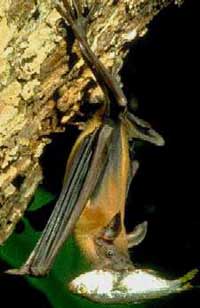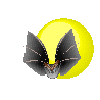 In Central and South America, there is a type of bat known for its fishing skills, scientifically named Noctilio Leporinus. This species of bat is robust, characterized by a V-shaped head, a pointed snout, and a short back. The males have a reddish-yellow back, while the females have a brown or gray back.
In Central and South America, there is a type of bat known for its fishing skills, scientifically named Noctilio Leporinus. This species of bat is robust, characterized by a V-shaped head, a pointed snout, and a short back. The males have a reddish-yellow back, while the females have a brown or gray back.
Fishing bats live in groups. During the day, they hang out sleeping in caves, rock crevices, or hollow tree trunks. By evening and throughout the night, they fly out to hunt for fish. With their curved and sharp claws, they can easily snatch unsuspecting fish swimming quietly in the dark. They accomplish this using echolocation techniques to detect the ripples created by fish swimming near the water’s surface.
Another unique skill of the fishing bat is its excellent swimming ability; they use their wings like paddles and can also catch and eat insects, as well as hard-shelled animals.
 Noctilio Leporinus gives birth between mid-December and March of the following year, although there are occasional exceptions. Each time, they have only one offspring.
Noctilio Leporinus gives birth between mid-December and March of the following year, although there are occasional exceptions. Each time, they have only one offspring.
An adult male typically measures about 10 centimeters in length and weighs approximately 54 grams.




















































